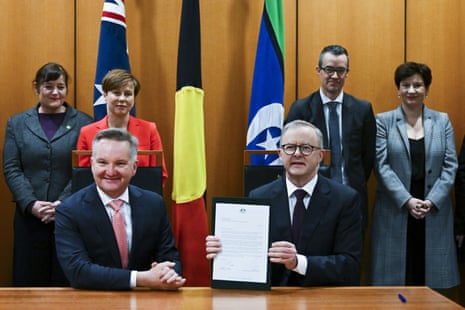Extract from The Guardian
Exclusive: A fierce internal debate raged as Anthony Albanese and Chris Bowen pushed for an ambitious climate policy for the 2022 federal election.

Fri 25 Nov 2022 01.00 AEDT
Last modified on Fri 25 Nov 2022 07.12 AEDTThe internal wrangling ahead of shadow cabinet’s decision to endorse the 2030 target in December 2021 is revealed in the new Quarterly Essay: Lone Wolf: Albanese and the New Politics, which will be published on Monday.
Anthony Albanese characterises Labor’s more ambitious climate policy as core to the identity of his government, and the foundation stone of a major diplomatic reboot with the Pacific, the US and European allies.
But landing a 2030 target in the 40s was not guaranteed. Internal resistance to an ambitious commitment during November and December 2021 was full-throated – significant enough, some Labor figures insist, to have derailed the policy.
Labor’s climate choice: to defend or attack
In the days before the 3 December shadow cabinet decision, an expanded leadership group, known internally as the Sunday night dinner group, met several times to assess options. There wasn’t unanimity about how to proceed, and that nervousness spilled over into the formal shadow cabinet deliberation, where shadow ministers fretted how a target in the 40s would influence outer-suburban election contests.
The opposition had mulled two conceptual climate policy options after the election defeat in 2019. The first was a defensive play – setting a new 2030 emissions reduction target in the low to mid-30s accompanied by funding for renewables and industry assistance for the transition. The second was an ambitious option – a target somewhere in the 40s, or perhaps the early 50s, engaging the Abbott-era safeguard mechanism to drive down industrial pollution.
Albanese made it known he did not want to replicate the 45% figure Labor took to the 2019 election. But he also made it clear to colleagues he favoured ambitious action.
The shadow climate change minister, Chris Bowen, also told colleagues he was not interested in tokenism – he favoured a target at the upper end of the ambitious range. Analysis undertaken by Reputex settled the number.
With the shadow cabinet deliberation looming in early December, Albanese dined privately in November with Jennifer Westacott, the chief executive of the Business Council of Australia, and the BCA’s president, Tim Reed.
He gave the business lobbyists an outline of where Labor was heading in an effort to secure public endorsement from the group, which had delivered a damaging blow to the Labor campaign in 2019 by characterising the previous 45% target as “economy wrecking”.
Given the turbulent preamble, Bowen went into the shadow cabinet discussion on 3 December heavily prepared with a presentation about the number of jobs that would be created in the transition. He was accompanied by a junior shadow minister, Pat Conroy, who emphasised a couple of elements of the Reputex modelling: coal-fired power stations would not close early, and emissions-intensive industries would not face more onerous regulation here than overseas.
The collective nervousness in the shadow cabinet reflected bitter electoral experience. Labor had lost every federal election since 2013 in part because of the climate wars unleashed by Tony Abbott.
If we had just matched the government on climate targets, we wouldn’t have won [seats like Higgins and Bennelong]
The internal climate deliberation after the 2019 defeat had also risked becoming enmeshed in incipient leadership jockeying, with veteran New South Wales rightwinger Joel Fitzgibbon running a public campaign for Labor to adopt the same 2030 target as the Coalition.
Senior figures close to Albanese were concerned Fitzgibbon’s campaign had the potential to escalate into a proxy war about leadership, so they assessed options to neutralise the problem.
A fresh set of eyes
By the middle of 2020, Albanese confidante Penny Wong, the shadow foreign affairs minister, advised the then opposition leader to execute a portfolio swap between the left faction’s Mark Butler – who held the climate policy until January 2021 – and the NSW rightwinger Chris Bowen, who was the shadow health minister.
Climate change was a major issue during the 2022 election. The Liberal party lost the teal contests in May as part of one of the most significant electoral realignments in recent political history.
Bowen says: “If we had just matched the government on climate targets, we wouldn’t have won [seats like Higgins and Bennelong] and probably those voters in Wentworth and Kooyong would have said, what’s the point? We can’t change anything, so what’s the point?”
* Lone Wolf: Albanese and the New Politics is published by Black Inc. An extract of Katharine Murphy’s latest Quarterly Essay will be published by Guardian Australia on Saturday.
No comments:
Post a Comment